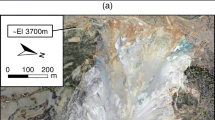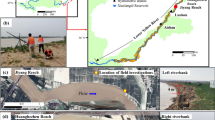Abstract
Earth internal seepage erosion in weathered bedrock under infrequently used hydraulic structures is often overlooked, which causes some solid particles to break away from the solid skeleton, degrading the earth’s strength, and even causing unanticipated hydraulic engineering failures. The flood on the Oroville dam spillway in California in 2017 was caused by disturbed water flow due to a crack in the spillway chute caused by internal erosion in poorly weathered bedrock. The abnormal water flow of the spillway in the early stage and subsequent investigation revealed that the main reason for the accident was the insufficient weathered bedrock under the spillway chute. In this study, we formulated a coupled hydro-mechanical mechanism for internal erosion in weathered bedrock during the early stages. Using this model, we conducted an internal erosion numerical simulation at early stage, and the results showed that the physical characteristics of the weathered bedrock were degraded. Our results show the coupling analysis of quantitative computation during the early stage of internal erosion in weathered bedrock, which can provide an early warning method for the occurrence of internal erosion to avoid hydraulic disasters.














Similar content being viewed by others
Data availability
All data generated or analyzed during this study are included in it and available from the corresponding author on reasonable request.
References
Bendahmane F, Marot D, Alexis A (2008) Experimental parametric study of suffusion and backward erosion. J Geotech Geoenviron Eng 134:57–67. https://doi.org/10.1061/(ASCE)1090-0241(2008)134:1(57)
Bernatek-Jakiel A, Poesen J (2018) Subsurface erosion by soil piping: significance and research needs. Earth Sci Rev 185:1107–1128. https://doi.org/10.1016/j.earscirev.2018.08.006
Bonelli S (2012) Erosion of geomaterials. John Wiley & Sons Inc, Hoboken
Carey SK, Woo MK (2000) The role of soil pipes as a slope runoff mechanism Subarctic Yukon, Canada. J Hydrol 233:206–222. https://doi.org/10.1016/s0022-1694(00)00234-1
Cividini A, Gioda G (2004) Finite-element approach to the erosion and transport of fine particles in granular soils. Int J Geomech 4(3):191–198
Coussy O (2004) Poromechanics. In: John wiley & Sons Ltd
Dunn ML, Ledbetter H (1995) Poisson’s ratio of porous and microcracked solids: theory and application to oxide superconductors. J Mater Res 10(11):2715–2722. https://doi.org/10.1557/jmr.1995.2715
France, J.W., Alvi, I.A., Dickson, P.A., Falvey, H.T., Rigbey, S.J. and Trojanowksi, J., 2018. Independent forensic team report: oroville dam spillway incident. url: https://damsafety.org/sites/default/files/files/ Independent Forensic Team Report Final 01–05–18. pdf.
Fujisawa, K., Niina, D., Murakmi, A., Nishimura, S., 2010. Coupled problem of saturated-unsaturated seepage flow and internal. Unsalturated Soils-Buzzi, Fityus& Sheng (eds).
García-Ruiz JM, Beguería S, Lana-Renault N, Nadal-Romero E, Cerdà A (2017) Ongoing and emerging questions in water erosion studies. L Degrad Dev 28:5–21. https://doi.org/10.1002/ldr.2641
Gratchev Ivan, Kim DH (2016) On the reliability of the strength retention ratio for estimating the strength of weathered rocks. Engineering Geology. 201:1–5. https://doi.org/10.1016/j.enggeo.2015.12.005
Hanson GJ, Tejral RD, Hunt SL, Temple DM (2010) Internal erosion and impact of erosion resistance. In: Proceedings of the 30th U.S. Society on Dams Annual Meeting and Conference, (CD-ROM), USSD, Sacramento, California, pp 773–784
Hollins LX, Eisenberg DA, Seager TP (2018) Risk and resilience at the Oroville Dam. Infrastructures 3(4):49. https://doi.org/10.3390/infrastructures3040049
Holly Nichols CEG (2019) Oroville dam flood control outlet spillway, Results of FCO Chute Geologic Investigation (Also filed as Project Geology Report No. 20-11-52). State of California Department of Water Resources Oroville Emergency Recovery – Spillways Technical Memorandum
Kacimov AR, Al-Maktoumi A, Obnosov YV (2019) Seepage through earth dam with clay core and toe drain: the Casagrande-Numerov analytical legacy revisited. ISH J Hydraul Eng. https://doi.org/10.1080/09715010.2019.1633694
Kacimov AR, Yakimov ND, Šimůnek J (2020) Phreatic seepage flow through an earth dam with an impeding strip. Computational Geosciences (in Press). https://doi.org/10.1007/s10596-019-09879-8
Matthews LR (2014) The Building of the Oroville Dam. Arcadia Publishing, Charleston, South Carolina
Phani KK, Sanyal D (2005) Critical Reevaluation of the Prediction of Effective Poisson’s Ratio for Porous Materials. J Mater Sci 40(21):5685–5690. https://doi.org/10.1007/s10853-005-1507-9
Poesen J (2018) Soil erosion in the Anthropocene: research needs. Earth Surf Process Landforms 43:64–84. https://doi.org/10.1002/esp.4250
Putty MRY, Prasad R (2000) Runoff processes in headwater catchments-an experimental study in Western Ghats. South India. J Hydrol 235:63–71. https://doi.org/10.1016/s0022-1694(00)00262-6
Reddi L, Lee I, Bonala M (2000) Comparison of internal and surface erosion using flow pump tests on a sand-Kaolinite Mixture. Geotech Test J 23(1):116–122. https://doi.org/10.1520/GTJ11129J
Rotunno AF, Callari C, Froiio F (2019) A finite element method for localized erosion in porous media with applications to backward piping in levees. Int J Numer Anal Methods Geomech 43:293–316. https://doi.org/10.1002/nag.2864
Satish M, Cho H, Kim DS (2016) Effect of bedrock stiffness and thickness of weathered rock on response spectrum in Korea. KSCE J Civil Eng 20(7):2677–2691. https://doi.org/10.1007/s12205-016-0811-z
Tuğrul A (2004) The effect of weathering on pore geometry and compressive strength of selected rock types from Turkey. Eng Geol 75:215–227. https://doi.org/10.1016/j.enggeo.2004.05.00
Vahedifard F, Robinson JD, AghaKouchak A (2016) Can protracted drought undermine the structural integrity of California’s earthen levees? J Geotech Geoenviron Eng ASCE 142(6):02516001–02516006. https://doi.org/10.1061/(ASCE)GT.1943-5606.0001465
Vardon P (2015) Climatic influence on geotechnical infrastructure: a review. Environ Geotech 2(3):166–174. https://doi.org/10.1680/envgeo.13.00055
Wang YS, Liu SH (2005) Treatment for a fully weathered rock dam foundation. Engineering Geology 77:115–126. https://doi.org/10.1016/j.enggeo.2004.08.006
Zhang X, Wang J, Wong H, Leo C, Liu Q, Tang Y, Yan X, Sun W, Huang Z, Hao X (2013a) Land subsidence caused by internal soil erosion owing to pumping confined aquifer groundwater during the deep foundation construction in Shanghai. Nat Hazards 69(10):473–489. https://doi.org/10.1007/s11069-013-0718-7
Zhang X, Wong H, Leo C, Bui T (2013b) A thermodynamics-based model on the internal erosion of earth structures. Geotech Geol Eng 31(2):479–492. https://doi.org/10.1007/s10706-012-9600-8
Zhang X, Wang CY, Wong H, Jiang T, Dong J (2022) Modeling dam deformation in the early stage of internal seepage erosion—application to the Teton Dam, Idaho, before the 1976 incident. J Hydrol 605:127378. https://doi.org/10.1016/j.jhydrol.2021.127378
Acknowledgements
The base material and data are supplied by the California Department of Water Resources, available for download at (show website).
Funding
This work was supported by the Key R&D and promotion projects in Henan Province (technical research) (No. 202102310018).
Author information
Authors and Affiliations
Contributions
All authors contributed to the study conception and design. Xingsheng Zhang, Chaoyue Wang, and Xing Chen mainly developed the geotechnical numerical model and performed numerical analyses. Jinyu Dong, Mengke Hu, and Shipeng Liu gathered in situ data for the geotechnical numerical model. All authors reviewed and revised the manuscript.
Corresponding authors
Ethics declarations
Ethics approval
Not applicable.
Consent to participate
Not applicable.
Consent for publication
All authors confirm that it is not under consideration for publication elsewhere.
Competing interests
The authors declare no competing interests.
Additional information
Responsible Editor: Philippe Garrigues
Publisher's Note
Springer Nature remains neutral with regard to jurisdictional claims in published maps and institutional affiliations.
Rights and permissions
Springer Nature or its licensor (e.g. a society or other partner) holds exclusive rights to this article under a publishing agreement with the author(s) or other rightsholder(s); author self-archiving of the accepted manuscript version of this article is solely governed by the terms of such publishing agreement and applicable law.
About this article
Cite this article
Zhang, X., Wang, C., Chen, X. et al. Insights into the cause of the Oroville dam spillway failure, 2017, California. Environ Sci Pollut Res 31, 21356–21369 (2024). https://doi.org/10.1007/s11356-024-32462-3
Received:
Accepted:
Published:
Issue Date:
DOI: https://doi.org/10.1007/s11356-024-32462-3




